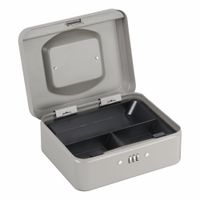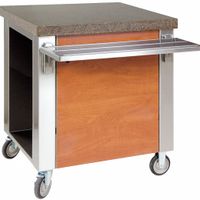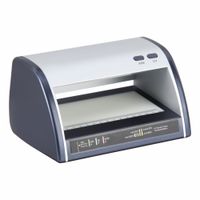Call +(254) 703 030 000 / 751 483 999 / 721 704 777
- Home
- Office Supplies
- Retail Supplies
.....Read More
Frequently Asked Questions
What are the best cash boxes for retail use?
The best cash boxes for retail use are those that offer a combination of security, durability, and functionality. Here are some top options:
1. **SentrySafe CB-12 Cash Box**: Known for its solid steel construction, this cash box offers a secure lock system and a removable tray for organizing coins and bills. It's compact yet spacious enough for retail needs.
2. **Jssmst Large Cash Box**: This box features a durable metal build with a reliable key lock. It includes a tiered tray for easy access to coins and bills, making it ideal for busy retail environments.
3. **KYODOLED Cash Box**: With a robust steel design, this cash box provides a secure locking mechanism and a removable tray for organizing cash. Its handle makes it portable, which is useful for mobile retail operations.
4. **MMF Industries STEELMASTER Cash Box**: This box is designed for heavy-duty use, featuring a sturdy steel construction and a secure lock. It includes a removable tray and additional compartments for checks and receipts.
5. **Royal Sovereign Cash Box**: This option offers a combination lock for added security and a removable tray for organizing cash. Its durable construction ensures long-lasting use in retail settings.
6. **Barska CB11794 Large Cash Box**: Known for its spacious interior, this cash box includes a removable tray and a secure key lock. It's ideal for retailers who handle a large volume of cash.
7. **Honeywell 6112 Security Box**: This box offers a digital lock for enhanced security and a removable tray for cash organization. Its solid steel construction ensures durability.
When choosing a cash box, consider factors such as the volume of cash handled, the level of security required, and the need for portability. These options provide a balance of security, organization, and ease of use, making them suitable for various retail environments.
How do deposit bags ensure the security of cash during transport?
Deposit bags ensure the security of cash during transport through several key features:
1. **Tamper-Evident Seals**: These bags are equipped with tamper-evident seals that show clear signs if someone attempts to open them. This deters unauthorized access and provides a clear indication if tampering has occurred.
2. **Durable Materials**: Made from strong, tear-resistant materials, deposit bags protect the contents from physical damage and environmental factors, ensuring the cash remains intact during transit.
3. **Unique Identification**: Each bag often has a unique serial number or barcode, allowing for easy tracking and accountability. This helps in maintaining a chain of custody and ensures that the bag can be traced throughout its journey.
4. **Security Features**: Some bags include additional security features such as watermarks, holograms, or color-changing inks that further prevent counterfeiting and unauthorized duplication.
5. **Locking Mechanisms**: Certain deposit bags come with built-in locking mechanisms that require a key or combination to open, adding an extra layer of security against theft.
6. **Audit Trails**: The use of deposit bags often involves documentation and logging, creating an audit trail that records who handled the bag and when, enhancing accountability and reducing the risk of internal theft.
7. **Visibility**: Transparent or semi-transparent designs allow for quick verification of contents without opening the bag, reducing the need for handling and potential exposure to theft.
8. **Insurance and Protocols**: The use of deposit bags is often part of a broader security protocol that includes insurance coverage and specific handling procedures, further safeguarding the cash during transport.
These features collectively ensure that cash remains secure from the point of collection to its final destination, minimizing the risk of loss or theft.
What features should I look for in a reliable coin and bill counter?
When selecting a reliable coin and bill counter, consider the following features:
1. **Counting Speed**: Look for machines with high counting speeds to handle large volumes efficiently. Bill counters should process at least 1,000 bills per minute, while coin counters should handle several hundred coins per minute.
2. **Capacity**: Ensure the hopper and stacker capacities meet your needs. Larger capacities reduce the frequency of reloading and emptying.
3. **Accuracy**: Choose models with high accuracy rates to minimize errors. Features like automatic error detection and correction are beneficial.
4. **Multi-Currency Support**: If you handle multiple currencies, opt for machines that can process different denominations and currencies.
5. **Counterfeit Detection**: Advanced counterfeit detection features, such as UV, magnetic, and infrared sensors, are crucial for identifying fake bills.
6. **Batching and Sorting**: Batching allows you to count specific quantities, while sorting features separate different denominations, saving time and effort.
7. **Ease of Use**: User-friendly interfaces with clear displays and simple controls enhance usability. Look for machines with intuitive operation and easy maintenance.
8. **Durability and Build Quality**: Robust construction ensures longevity, especially in high-volume environments. Metal components are generally more durable than plastic.
9. **Portability**: If mobility is important, consider the machine's size and weight. Portable models are ideal for businesses that require flexibility.
10. **Noise Level**: Quieter machines are preferable in environments where noise is a concern.
11. **Connectivity**: Some models offer connectivity options like USB or Bluetooth for data transfer and integration with accounting systems.
12. **Warranty and Support**: A good warranty and reliable customer support are essential for addressing any issues that may arise.
13. **Price**: Balance your budget with the features you need, ensuring you get the best value for your investment.
How can I effectively detect counterfeit currency in my store?
To effectively detect counterfeit currency in your store, implement a multi-layered approach:
1. **Training Staff**: Educate employees on identifying counterfeit bills. Focus on security features like watermarks, color-shifting ink, and security threads. Use online resources or workshops for comprehensive training.
2. **Use of Detection Tools**: Invest in counterfeit detection devices such as UV light detectors, magnetic ink detectors, and infrared scanners. These tools can quickly identify fake notes by highlighting security features not present in counterfeit bills.
3. **Check Security Features**: Familiarize yourself with the specific security features of the currency you handle. For example, U.S. bills have color-shifting ink, microprinting, and raised printing. Regularly update your knowledge as currency designs evolve.
4. **Feel and Texture**: Genuine currency is printed on special paper that feels different from regular paper. Train staff to recognize the unique texture and sound of authentic bills.
5. **Visual Inspection**: Encourage staff to visually inspect bills for inconsistencies in color, size, and design. Counterfeit notes often have blurry borders, off-center printing, or incorrect colors.
6. **Use of Pens**: Counterfeit detection pens can be used as a quick check. These pens react with starch in regular paper, leaving a dark mark on fake bills. However, they are not foolproof and should be used in conjunction with other methods.
7. **Regular Audits**: Conduct regular audits of cash registers to ensure all bills are authentic. This practice helps in early detection and prevents circulation of counterfeit currency.
8. **Report Suspicious Bills**: If a counterfeit bill is detected, report it to the authorities immediately. Keep the bill and note details about the transaction and the person who used it.
By combining these strategies, you can significantly reduce the risk of counterfeit currency in your store.
What are the benefits of using pricing guns and labels in retail?
Pricing guns and labels offer several benefits in retail settings:
1. **Efficiency**: Pricing guns allow for quick and easy labeling of products, significantly reducing the time required for manual pricing. This efficiency is crucial during inventory updates or when new stock arrives.
2. **Accuracy**: By using pricing guns, retailers can minimize human error associated with manual price tagging. This ensures that the correct price is displayed, reducing discrepancies at checkout.
3. **Cost-Effective**: Investing in pricing guns is cost-effective in the long run. They reduce the need for additional labor and speed up the pricing process, leading to savings on operational costs.
4. **Flexibility**: Pricing guns are versatile and can be used on a variety of products, regardless of size or shape. This flexibility is beneficial for stores with diverse inventories.
5. **Improved Inventory Management**: Consistent and clear labeling helps in better inventory management. It allows for easy tracking of stock levels and aids in quick restocking decisions.
6. **Enhanced Customer Experience**: Clear and accurate pricing improves the shopping experience by reducing confusion and ensuring customers are informed about product costs, leading to increased customer satisfaction.
7. **Promotional Adaptability**: Pricing guns make it easy to update prices for sales or promotions, allowing retailers to quickly adapt to market changes or promotional strategies.
8. **Professional Appearance**: Uniform labels provide a professional look to the store, enhancing brand image and customer trust.
9. **Security**: Pricing guns can help deter theft by making it more difficult for price tags to be altered or removed without detection.
10. **Compliance**: They ensure compliance with pricing regulations by providing clear and consistent price displays, which is essential for legal and customer trust reasons.
How do I choose the right paper rolls for my point-of-sale system?
To choose the right paper rolls for your point-of-sale (POS) system, consider the following factors:
1. **Printer Type**: Identify whether your POS system uses a thermal or impact printer. Thermal printers require thermal paper, while impact printers use bond paper with ink ribbons.
2. **Paper Size**: Check the printer’s manual or the existing paper roll for the correct width and diameter. Common widths are 57mm and 80mm, but always confirm the specific size for your printer model.
3. **Core Size**: Ensure the core size of the paper roll matches your printer’s specifications. Standard core sizes are typically 12.7mm (0.5 inches).
4. **Length and Diameter**: Consider the roll length and outer diameter to ensure it fits within the printer compartment. Longer rolls reduce the frequency of replacements but must fit the printer.
5. **Quality and Thickness**: Opt for high-quality paper to ensure clear printing and reduce wear on the printer. Thicker paper is more durable but may require adjustments in printer settings.
6. **End-of-Roll Indicator**: Some rolls have a red stripe near the end to alert you when it’s time to replace the roll, which can be useful for uninterrupted operations.
7. **Environmental Considerations**: If sustainability is a priority, look for eco-friendly options like BPA-free or recycled paper.
8. **Cost and Supplier**: Balance cost with quality. Purchase from reputable suppliers to ensure consistent quality and availability.
9. **Special Features**: Consider additional features like pre-printed logos or watermarks if they align with your business needs.
By evaluating these factors, you can select the appropriate paper rolls that ensure efficient and reliable operation of your POS system.
What are the advantages of implementing a queuing system in my store?
Implementing a queuing system in your store offers several advantages that enhance both customer experience and operational efficiency. Firstly, it reduces wait times by organizing customer flow, ensuring that service is provided in an orderly manner. This minimizes frustration and enhances customer satisfaction, encouraging repeat business and positive word-of-mouth.
Secondly, a queuing system can optimize staff allocation. By analyzing queue data, you can identify peak times and adjust staffing levels accordingly, ensuring that resources are used efficiently without overstaffing or understaffing.
Thirdly, it provides valuable data insights. By tracking customer flow and wait times, you can gain insights into customer behavior and store performance. This data can inform decisions on store layout, staffing, and service improvements.
Fourthly, it enhances fairness and transparency. Customers appreciate knowing their position in line and expected wait time, which a queuing system can provide. This transparency builds trust and reduces perceived wait times, as customers are more patient when they know what to expect.
Fifthly, it can improve safety and comfort. By managing the number of people in a given area, a queuing system can help maintain social distancing and reduce overcrowding, which is particularly important in health-conscious environments.
Lastly, it can integrate with other systems for a seamless experience. Modern queuing systems can be integrated with mobile apps, allowing customers to join a queue remotely and receive notifications when it’s their turn, further enhancing convenience and reducing physical congestion in the store.
Overall, a queuing system streamlines operations, improves customer satisfaction, and provides actionable insights, making it a valuable investment for any store looking to enhance its service quality and operational efficiency.
How can suggestion boxes improve customer and employee feedback collection?
Suggestion boxes can significantly enhance feedback collection from both customers and employees by providing a structured yet flexible platform for communication. For customers, suggestion boxes offer an anonymous and convenient way to express their opinions, concerns, and ideas without the pressure of face-to-face interactions. This anonymity can lead to more honest and constructive feedback, which businesses can use to improve products, services, and customer experiences. By strategically placing suggestion boxes in accessible locations, businesses can capture a wide range of customer insights, helping to identify trends and areas for improvement.
For employees, suggestion boxes serve as a channel to voice their thoughts on workplace conditions, management practices, and organizational policies. This can foster a culture of openness and inclusivity, where employees feel valued and heard. Anonymity in employee suggestion boxes encourages candid feedback, which can reveal underlying issues that might not surface in regular meetings or surveys. By actively soliciting and responding to employee suggestions, organizations can enhance job satisfaction, boost morale, and increase productivity.
Moreover, suggestion boxes can be a cost-effective feedback tool, requiring minimal resources to implement and maintain. They can be physical or digital, with digital options offering the advantage of easier data collection and analysis. Regularly reviewing and acting on the feedback collected through suggestion boxes demonstrates a commitment to continuous improvement and can strengthen relationships with both customers and employees. By closing the feedback loop—acknowledging suggestions and communicating any resulting changes—organizations can build trust and loyalty, ultimately leading to better business outcomes.
What are the benefits of using transparent dividers at checkout counters?
Transparent dividers at checkout counters offer several benefits:
1. **Health and Safety**: They act as a physical barrier to reduce the transmission of airborne pathogens, such as viruses and bacteria, between customers and cashiers. This is particularly important in maintaining public health during pandemics or flu seasons.
2. **Customer Confidence**: By visibly demonstrating a commitment to health and safety, businesses can enhance customer confidence, encouraging more people to shop in-store.
3. **Employee Protection**: Protecting employees from potential exposure to illnesses can lead to fewer sick days and a healthier work environment, which in turn can improve staff morale and productivity.
4. **Clear Communication**: Being transparent, these dividers do not obstruct the view, allowing for clear communication between customers and cashiers, which is essential for efficient service.
5. **Cost-Effective**: Compared to other structural changes, transparent dividers are relatively inexpensive to install and maintain, making them a cost-effective solution for enhancing safety.
6. **Versatility**: They can be easily installed and removed, allowing businesses to adapt quickly to changing health guidelines or store layouts.
7. **Aesthetic Appeal**: Transparent dividers maintain the visual openness of a store, preserving the aesthetic appeal and ensuring that the space does not feel closed off or unwelcoming.
8. **Customizable**: They can be customized in size and shape to fit different counter designs and can include branding elements, enhancing the store's visual identity.
9. **Privacy**: They provide a degree of privacy for transactions, which can be appreciated by customers when handling sensitive payment information.
10. **Durability**: Made from materials like acrylic or polycarbonate, these dividers are durable and resistant to impact, ensuring long-term use.
How can a cashier stand cart enhance the efficiency of my retail operations?
A cashier stand cart can significantly enhance the efficiency of retail operations in several ways:
1. **Mobility and Flexibility**: A cashier stand cart allows for mobility within the store, enabling cashiers to move to areas with high customer traffic. This flexibility can reduce wait times and improve customer service, especially during peak hours or special events.
2. **Space Optimization**: By using a mobile cart, retailers can optimize floor space. This is particularly beneficial for small stores or pop-up shops where space is limited. The cart can be positioned strategically to manage customer flow and reduce congestion.
3. **Improved Customer Experience**: With the ability to process transactions anywhere in the store, customers can enjoy a more personalized shopping experience. This convenience can lead to increased customer satisfaction and loyalty.
4. **Streamlined Operations**: A cashier stand cart can be equipped with all necessary tools, such as a POS system, barcode scanner, and receipt printer, allowing for seamless transactions. This setup minimizes the need for customers to queue at a fixed checkout point, thus speeding up the checkout process.
5. **Enhanced Inventory Management**: Some carts can be integrated with inventory management systems, allowing cashiers to update stock levels in real-time. This capability helps in maintaining accurate inventory records and reduces the likelihood of stockouts or overstocking.
6. **Cost-Effectiveness**: Investing in a mobile cashier stand can be more cost-effective than installing multiple fixed checkout counters. It reduces the need for additional infrastructure and can be easily relocated or repurposed as needed.
7. **Adaptability**: The cart can be customized to fit specific retail needs, such as adding promotional displays or integrating with digital signage, enhancing marketing efforts and driving sales.
Overall, a cashier stand cart can lead to more efficient operations, better customer service, and increased sales, making it a valuable asset for any retail business.








